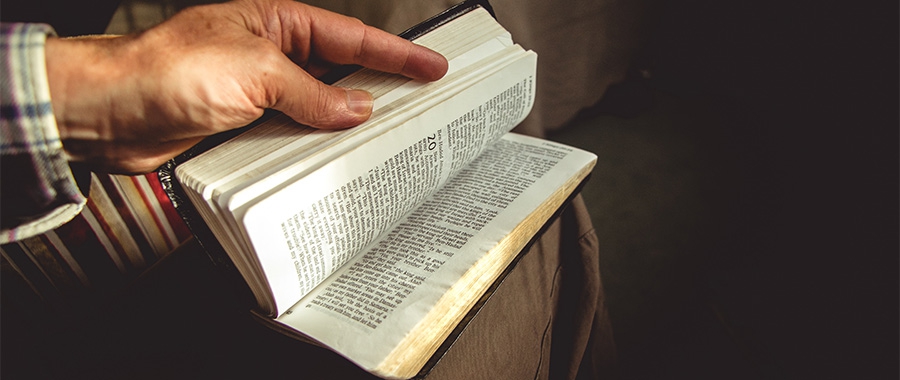The views expressed in our content reflect individual perspectives and do not represent the authoritative views of the Baha'i Faith.
Since the Book of Revelation offers a prophetic look into the future, its fulfillment is also prophetic.
Because the “Apocalypse of St. John the Divine”—an alternative name for the Book of Revelation—was written by a prophet, it makes perfect sense that its interpretation is best given by another prophet—especially by the prophet who fulfills the prophecies in the Book of Revelation, Baha’u’llah.
Baha’is believe that the Book of Revelation foretells the coming of Baha’u’llah, the prophet and founder of the Baha’i Faith, and that Baha’u’llah has interpreted the major symbolic imagery of the Book of Revelation in his Book of Certitude, which he revealed in January of 1861. Baha’u’llah wrote:
Wert thou to cleanse the mirror of thy heart from the dust of malice, thou wouldst apprehend the meaning of the symbolic terms revealed by the all-embracing Word of God made manifest in every Dispensation, and wouldst discover the mysteries of divine knowledge. – Baha’u’llah, The Book of Certitude, p. 68.
Based on Baha’u’llah’s interpretations—as well as those of Baha’u’llah’s successor and interpreter, Abdu’l-Baha, and of his successor, Shoghi Effendi, as well—individual Baha’is can offer their own personal interpretations of prophecy, with the disclaimer that such interpretations remain personal and not official or authoritative in any way.
With that disclaimer in mind, let’s take a look at one chapter in the Book of Revelation, Chapter 20. (The following interpretation, offered here, is by special request. In a comment, posted on February 16, 2019, a reader asked me to offer a Baha’i interpretation of Chapter 20 of the Book of Revelation: “Hope you will be addressing the meaning of these images in Revelation from the Baha’i perspective.”)
In evaluating this section of the Book of Revelation, we venture into new territory, although the Biblical literary landscape and the symbolic imagery are familiar. Thus the interpretation of Chapter 20 of the Book of Revelation may be undertaken primarily by applying authoritative Baha’i interpretations of similar prophetic texts, especially of other passages of the Book of Revelation itself.
So, before embarking on this new adventure, let me say a few prefatory words about prophecy in relation to the basic Baha’i principle of the harmony of science and religion. Here, the interpretation of prophecy should begin with a discussion of what the science of scholarship has to offer—then a religiously inspired and motivated interpretation can follow. In this way, we can achieve a certain harmony of science and religion. By so doing, we can discover spiritually-inspired and religiously-informed interpretations of prophecy, while at the same time acknowledging and respecting the results of critical scholarship in the academic study of religion.
In Biblical scholarship, the Book of Revelation is best interpreted by way of an “intertextual” reading, which refers to a network of references to related Biblical texts. The Book of Revelation abounds in allusions to passages in the so-called Old Testament. Identifying such “intertexts” amplifies and elucidates the passages in question.
For instance, the allusion “Gog and Magog” in Revelation 20:8 recalls, in the mind of the Biblically literate reader, the prophetic passage in Ezekiel, Chapters 38–39, where a hostile nation from the north will attack Palestine “in the latter days,” but this invader will be utterly vanquished. Therefore the reader of the narrative in Rev. 20:7–10 will naturally regard this event as the fulfillment of Ezekiel’s ancient prophecy of the defeat of God’s enemies in the last days.
Consider this interesting and enlightening statement by Biblical scholar David L. Barr:
A common and helpful metaphor to guide interpretation of a text is to reflect on the three worlds implicit in every text. There is the world within the text, the world behind the text, and the world in front of the text.
[1] Of course the one most apparent to us is the world contained within the text—a world of … Lambs and dragons, beautiful women and beasts, heavenly messengers and human observers. … So there is a dragon in the text, but there were no dragons in the world of the audience.
[2] To understand the dragon in the text, we need to explore the world behind the text, the historical and social world that generated these images, characters, and actions. …
[3] Now without question, this world in front of the text can distort our reading. We have a whole series of best-selling novels called the “Left Behind” series, imagining what will happen on earth after the “Rapture.” This apparently makes good sense to people even though Revelation makes no mention of any rapture, and in fact the notion was invented only in the nineteenth century. But because it has become such a part of our world in front of the text, people see it in the text. In the same way, most of my students are so immersed in readings like Hal Lindsay’s The Late Great Planet Earth that they think that that is what the story says. But of course it is not. While claiming to be a literal reading, this modern interpretation engages in the most outlandish allegorization of the text: the Beast is Russia (or China), the Ten Kings are the European Union, Babylon was, according to Lindsey, a code for a “one world religion.” – David L. Barr, “Beyond Genre: The Expectations of Apocalypse,” in The Reality of Apocalypse: Rhetoric and Politics in the Book of Revelation, pp. 71–73.
In the Book of Revelation, the “dragon” appears time and again, becoming central to the cosmic “combat myth” depicted throughout. The dragon is a powerful (and, in the Christian context, imperial) antagonist, who wages an eschatological war against the righteous and faithful servants of God. The dragon—a chaos monster familiar to students of ancient Near Eastern mythology—is as symbolic as it is destructive and coercive, and is central to the symbolic universe of the Book of Revelation.
Revelation 20 has two literary units: (1) the defeat of Satan (20:1–10), and (2) the vision of the judgment of the dead (20:11–15). In reading and analyzing those two units, it is important to bear in mind that the Book of Revelation was written to seven churches in Asia minor, and had a contemporary message for Christians at that time, who were experiencing relentless religious persecution by the Roman authorities. Revelation’s basic message is that persecuted Christians, if they remain faithful and endure these trials and tribulations, will experience ultimate victory in the Day of Resurrection.
A Baha’i interpretation of the Book of Revelation, after acknowledging the existence of a previous, and immediate, historical-contemporary context, can then apply the prophetic patterns in the Book of Revelation to a present-day context. In this sense, the Book of Revelation is reenacted (and re-fulfilled) without doing violence to the original meaning of the text.
For Baha’is, the Bab and Baha’u’llah represent a messianic duo who inaugurate a new religious dispensation:
Abraham, Moses, Zoroaster, Buddha, Jesus, Muhammad, the Bab and Baha’u’llah are one in spirit and reality. Moreover, each Prophet fulfilled the promise of the One Who came before Him and, likewise, Each announced the One Who would follow. – Abdu’l-Baha, The Promulgation of Universal Peace, p. 197.
As in early Christianity, the early days of the Babi and Baha’i religions were marked by intense religious persecution as well. Some 20,000 followers of the Bab were martyred. Many early Baha’is sacrificed their lives in the face of relentless persecution. This time around, it was Persia, not Rome, which was the state-sponsor of these persecutions—aided and abetted by the Muslim clergy in Persia at that time. In that sense, Persia became the new Rome.
In the next essay in this series, we’ll explore how Chapter 20 of the Book of Revelation announced the prophet who would follow the revelation of Christ.
You May Also Like
Comments

















But he, being full of the Holy Ghost, looked up stedfastly into heaven, and saw the glory of God, and Jesus standing on the right hand of God.
--
This phrasing emphasizes that he saw both the "Glory of God" (interpreted as Bahá'u'lláh in the Bahá'í Faith) and Jesus.
And I saw thrones, and they sat upon them, and judgment was given unto them: and I saw the souls of them that were beheaded for the witness of Jesus, and for the word of God, and which had not worshipped the beast, neither his image, neither had received his mark upon their foreheads, or in their hands; and they lived and reigned with Christ a thousand years.
--
If I'm not mistaken, this is talking about the Bahá'í martyrs.
The Bahá'í Faith teaches that its revelation will last for at least 1,000 years.